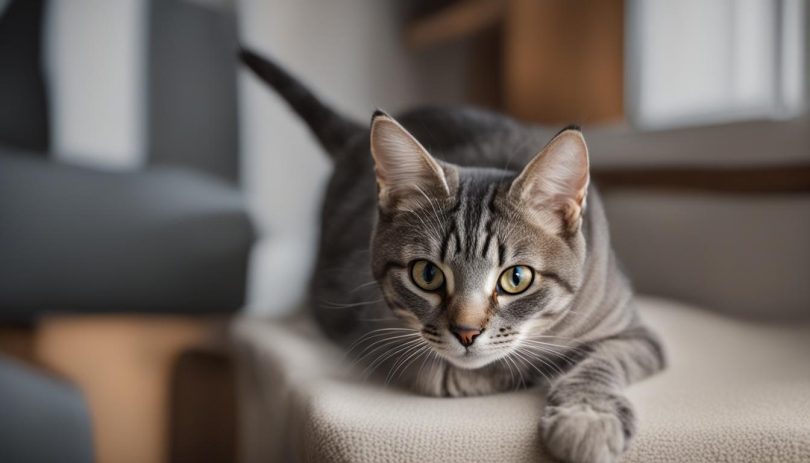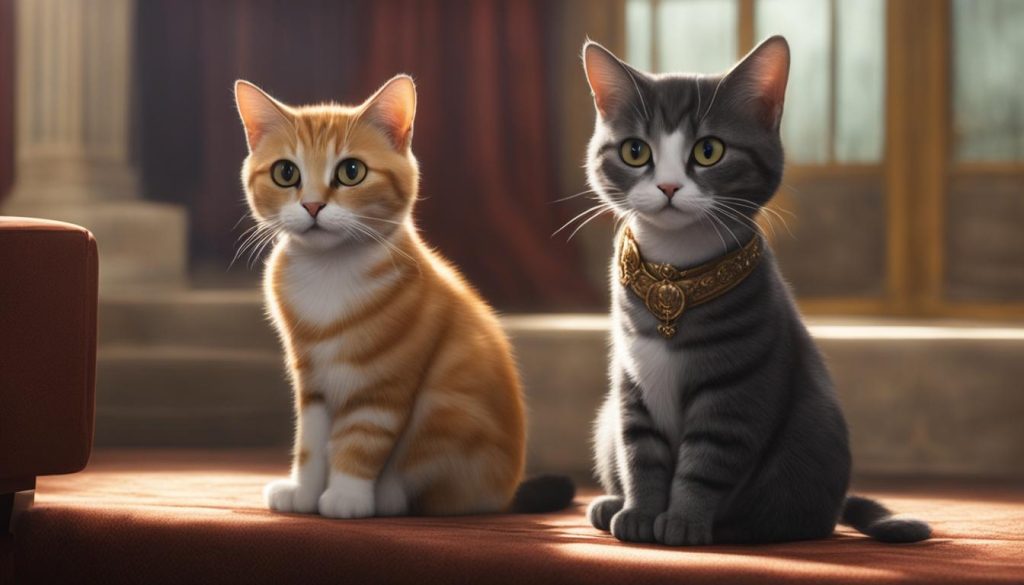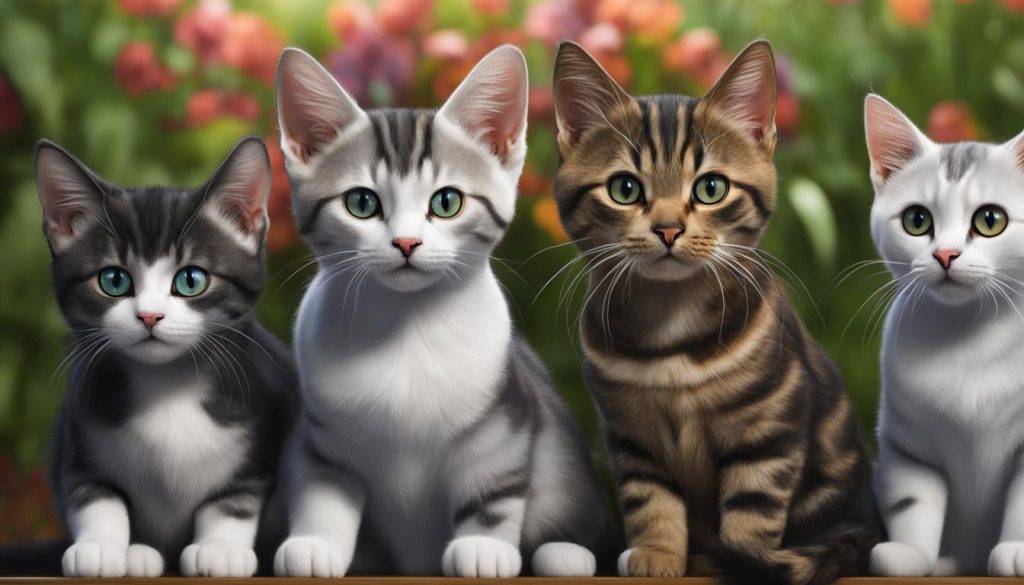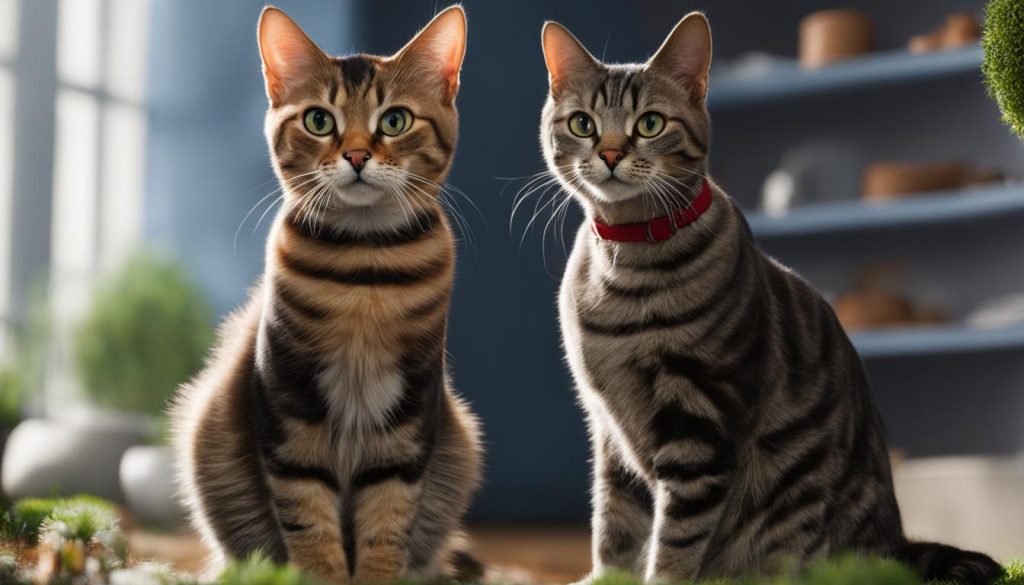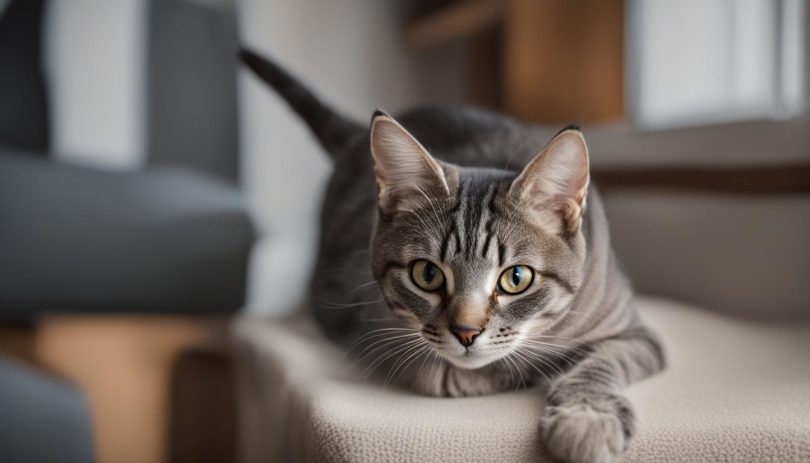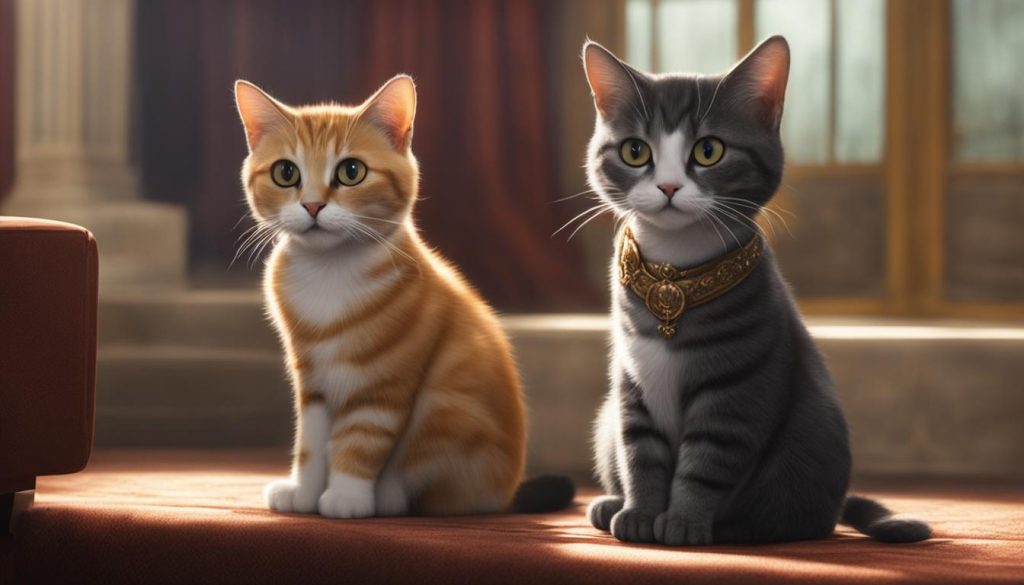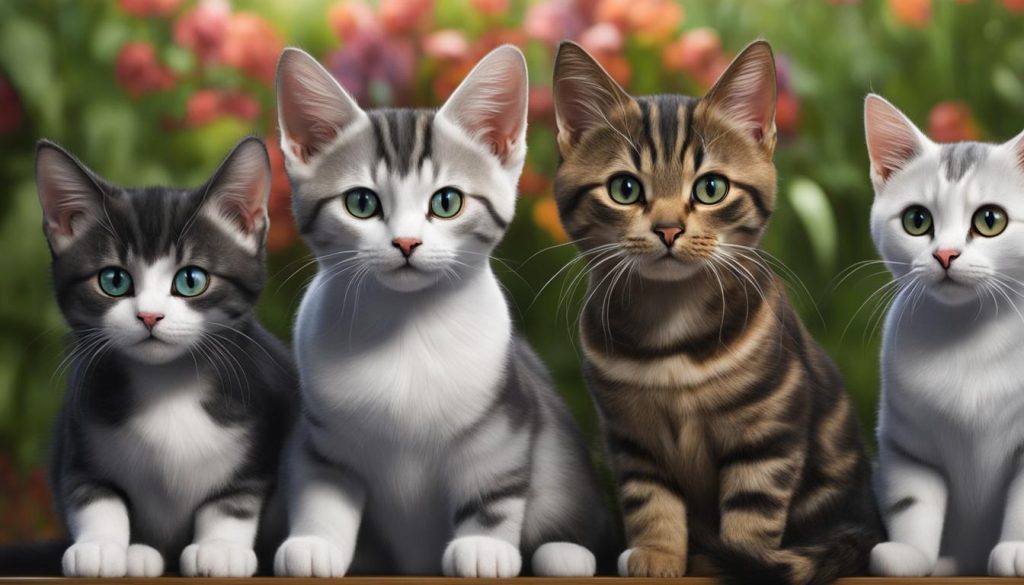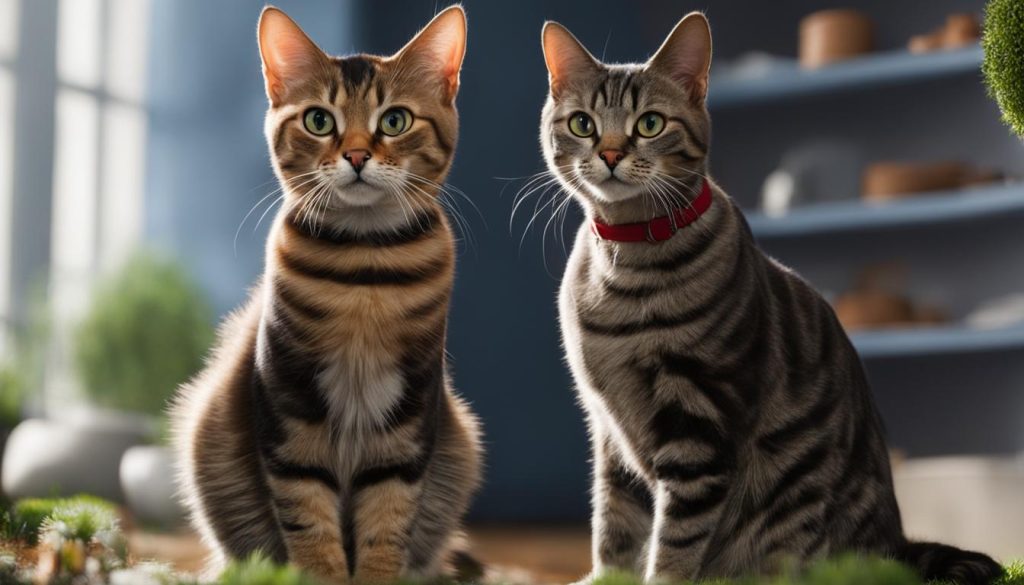In the vast world of cat breeds, two popular choices stand out: the Domestic Shorthair and the European Shorthair. While they may share similarities, they each possess unique characteristics and traits that set them apart. In this article, I will delve into the distinctive features of these fascinating feline breeds, exploring their size, coat type, temperament, lifespan, exercise and grooming needs, as well as their origins.
Key Takeaways:
- The Domestic Shorthair and European Shorthair are distinct cat breeds with unique characteristics.
- They differ in size, coat type, temperament, and exercise and grooming needs.
- Both breeds have a similar lifespan of 15-20 years.
- European Shorthairs may be more prone to genetic conditions, while American Shorthairs may be more susceptible to obesity-related health issues.
- Choosing between the two breeds depends on personal preferences and lifestyle.
Size and Coat Type Comparison
When comparing the size and coat type of Domestic Shorthair and European Shorthair cats, there are noticeable differences between the two breeds.
The European Shorthair is slightly larger than the Domestic Shorthair, weighing between 10 to 15 pounds and growing to a height of 9 to 11 inches. On the other hand, the Domestic Shorthair weighs around 8 to 12 pounds and typically reaches a height of 8 to 10 inches. This size difference may influence the overall appearance and presence of the cats.
One of the most significant differences between the two breeds is their coat type. European Shorthairs have longer and denser coats compared to the Domestic Shorthair, which has shorter and thicker fur. The European Shorthair’s longer coat requires more grooming maintenance to prevent matting and keep it in optimal condition. In contrast, the Domestic Shorthair’s shorter coat is generally easier to care for and requires less frequent grooming.
| Size Comparison | Domestic Shorthair | European Shorthair |
|---|---|---|
| Weight | 8-12 pounds | 10-15 pounds |
| Height | 8-10 inches | 9-11 inches |
| Coat Type Comparison | Domestic Shorthair | European Shorthair |
|---|---|---|
| Fur Length | Shorter | Longer |
| Grooming Needs | Low maintenance | Requires more frequent grooming |
The size and coat type comparison between Domestic Shorthair and European Shorthair cats highlights the distinct physical characteristics of each breed. While the European Shorthair is larger and has longer fur, the Domestic Shorthair is more compact with a shorter coat. These differences contribute to the unique appearance and grooming needs of each breed.
Temperament and Personality Traits
When considering a furry companion, understanding their temperament and personality traits is crucial. This is no different when it comes to comparing the Domestic Shorthair and European Shorthair breeds. While both breeds make excellent companions, there are distinct differences in their temperaments and personalities.
The Domestic Shorthair is known for its friendly and easy-going nature. These cats are typically outgoing, affectionate, and enjoy being around people. They have a reputation for being social butterflies, getting along well with both humans and other pets. Their playful and sociable nature makes them a great choice for families and individuals looking for a loving and interactive companion.
In contrast, the European Shorthair may exhibit a slightly more reserved and independent personality. While they are still loyal and loving, they tend to be more independent and may require a bit more personal space. However, once they form a bond with their human, they can be extremely devoted. They are known for their intelligence and adaptability, making them an excellent choice for individuals who appreciate a cat that enjoys their own company while still being a steadfast companion.
Both breeds have their unique temperamental traits that make them special in their own right. While Domestic Shorthairs are typically more outgoing and affectionate, European Shorthairs are known for their independence and loyalty. Ultimately, the choice between these two breeds will depend on your personal preferences and the type of companionship you are looking for in a feline friend.
Temperament and Personality Traits
When considering a furry companion, understanding their temperament and personality traits is crucial. This is no different when it comes to comparing the Domestic Shorthair and European Shorthair breeds. While both breeds make excellent companions, there are distinct differences in their temperaments and personalities.
The Domestic Shorthair is known for its friendly and easy-going nature. These cats are typically outgoing, affectionate, and enjoy being around people. They have a reputation for being social butterflies, getting along well with both humans and other pets. Their playful and sociable nature makes them a great choice for families and individuals looking for a loving and interactive companion.
In contrast, the European Shorthair may exhibit a slightly more reserved and independent personality. While they are still loyal and loving, they tend to be more independent and may require a bit more personal space. However, once they form a bond with their human, they can be extremely devoted. They are known for their intelligence and adaptability, making them an excellent choice for individuals who appreciate a cat that enjoys their own company while still being a steadfast companion.
Both breeds have their unique temperamental traits that make them special in their own right. While Domestic Shorthairs are typically more outgoing and affectionate, European Shorthairs are known for their independence and loyalty. Ultimately, the choice between these two breeds will depend on your personal preferences and the type of companionship you are looking for in a feline friend.
Lifespan and Health
When it comes to lifespan and health, both domestic shorthairs and European shorthairs have relatively long lifespans of 15-20 years. However, it’s important to note that each breed may be prone to certain genetic conditions and health issues.
European shorthairs are known to have a higher risk of developing genetic conditions such as hypertrophic cardiomyopathy (HCM) and polycystic kidney disease (PKD). Regular veterinary check-ups and screenings can help detect these conditions early on and allow for proper management and treatment.
On the other hand, American shorthairs may be more susceptible to obesity-related health issues. Due to their stockier build and slower metabolism, these cats may be more prone to weight gain. It’s important to provide them with a balanced diet and regular exercise to maintain a healthy weight and prevent obesity-related complications.
| Breed | Lifespan | Common Health Conditions |
|---|---|---|
| Domestic Shorthair | 15-20 years | Obesity-related health issues |
| European Shorthair | 15-20 years | Hypertrophic cardiomyopathy (HCM) Polycystic kidney disease (PKD) |
By providing proper care, nutrition, and regular veterinary check-ups, both domestic and European shorthairs can lead healthy and fulfilling lives.
Exercise and Grooming Needs
When it comes to exercise and grooming needs, both the domestic shorthair and European shorthair have moderate requirements. Regular playtime and physical activity are essential for keeping these breeds healthy and happy.
The European Shorthair, being slightly larger in size, may have more energy to burn and may enjoy exploring outdoor spaces. Providing them with opportunities for supervised outdoor time can help meet their exercise needs. On the other hand, the domestic shorthair is also active and benefits from interactive toys and play sessions indoors.
In terms of grooming, the European Shorthair requires more frequent grooming due to their longer coats. Regular brushing helps prevent matting and keeps their coat looking its best. On the other hand, the domestic shorthair’s shorter coat is easier to maintain and typically requires less grooming. Occasional brushing to remove loose hairs and regular nail trimming should suffice for their grooming needs.
Exercise and Grooming Comparison
To summarize the exercise and grooming needs of both breeds:
| Exercise Needs | Grooming Needs | |
|---|---|---|
| Domestic Shorthair | Moderate exercise needs. Indoor playtime and interactive toys are sufficient. | Minimal grooming needs. Occasional brushing and nail trimming are recommended. |
| European Shorthair | Moderate exercise needs. Enjoys outdoor exploration and playtime. | More frequent grooming required. Regular brushing is necessary to maintain coat health. |
Both breeds can adapt well to different living environments and are suitable for families, individuals, and homes with other pets. However, it’s important to note that individual cats may have varying exercise and grooming needs, so it’s important to assess and provide for their specific requirements.
Nationality and Breed Origins
When it comes to the Domestic Shorthair and European Shorthair breeds, their origins play a significant role in their unique characteristics and traits. The European Shorthair, also known as the British Shorthair, is the national cat of Finland and has its roots in Italy. Fascinatingly, these cats were initially kept on ships to control rodent populations, showcasing their natural hunting instincts and adaptability.
On the other hand, the American Shorthair is native to the United States and has a rich history as well. These cats were brought to America to protect cargo from mice and rats, highlighting their practical and working qualities. Both breeds have deep roots in their respective countries and have played significant roles in their societies.
European Shorthairs and American Shorthairs have distinctive nationalities and breed origins, which have shaped their unique characteristics and roles in different cultures. While European Shorthairs have a strong connection to Italy and Finland, American Shorthairs have firmly established themselves as an integral part of American history. It’s fascinating to see how these cats have evolved over time and adapted to different environments.
Understanding the nationality and breed origins of these cats adds an extra layer of appreciation for their heritage and the traits they bring to the table. Whether you’re drawn to the European Shorthair’s international allure or the American Shorthair’s patriotic roots, both breeds offer wonderful companionship and can make a delightful addition to any loving home.
Table: Breed Origins Comparison
| Breed | Origin | Nationality |
|---|---|---|
| European Shorthair | Italy | Finland |
| American Shorthair | United States | United States |
| Domestic Shorthair | European Shorthair | |
|---|---|---|
| Size | Medium | Slightly larger |
| Coat Type | Short and thick | Longer and denser |
| Temperament | Friendly and easy-going | Reserved yet loyal |
| Lifespan | 15-20 years | 15-20 years |
| Exercise Needs | Moderate | Moderate to high |
| Grooming Needs | Low | Higher maintenance |
Overall, while domestic shorthairs and European shorthairs may have their differences, they are both beloved cat breeds that can bring joy and companionship to any home. Whether you’re looking for a playful and affectionate companion or a more independent yet loyal feline friend, both breeds have qualities that make them wonderful additions to the family.
Next, let’s take a closer look at the visual differences between domestic shorthairs and European shorthairs, as well as their suitability for different living situations.
Visual Differences and Suitability
When comparing the appearance of Domestic Shorthairs and European Shorthairs, there are notable visual differences that set these two breeds apart. European Shorthairs have a more muscular and stockier build compared to American Shorthairs. Their bodies are round and compact, complemented by round faces and expressive eyes.
Both breeds exhibit a wide range of coat colors and patterns. Domestic Shorthairs come in various coat lengths and textures, but they generally have shorter and thicker coats. On the other hand, European Shorthairs have longer and denser coats that require more frequent grooming to prevent matting and tangles.
Regarding suitability, both Domestic Shorthairs and European Shorthairs make excellent companions for families, individuals, and households with other pets. However, it’s important to consider the temperament of each breed. European Shorthairs tend to be more reserved and shy around strangers, while American Shorthairs are typically more outgoing and sociable. If you’re looking for a cat that is more independent yet loyal, the European Shorthair may be the ideal choice.
| Visual Differences | Domesic Shorthair | European Shorthair |
|---|---|---|
| Build | Slightly smaller and leaner | More muscular and stocky |
| Coat | Shorter and thicker | Longer and denser |
| Temperament | Outgoing and sociable | Reserved and shy around strangers |
In conclusion, the visual differences between Domestic Shorthairs and European Shorthairs are mainly evident in their build, coat type, and temperament. However, both breeds are suitable for various living situations and make wonderful companions. It ultimately comes down to personal preference and the specific qualities you are seeking in a feline companion.
Conclusion
After comparing the domestic shorthair and European shorthair, it’s clear that both breeds have their own unique characteristics and qualities that make them wonderful companions. The decision between these two breeds comes down to personal preferences and lifestyle.
When considering the domestic shorthair, you’ll find a friendly and easy-going cat that is outgoing and affectionate. They are adaptable to different environments and get along well with other pets. Their shorter and thicker coats require less grooming maintenance, making them ideal for those looking for a low-maintenance companion.
If you prefer a slightly larger cat with a more reserved and independent personality, the European shorthair may be the breed for you. They are known for their loyalty and can be independent yet loving. With their longer and denser coats, they require more grooming, but their striking appearance and unique colors make it worth the extra effort.
Ultimately, the best breed for you will depend on your preferences and the environment in which the cat will live. Both domestic shorthairs and European shorthairs can provide years of love and companionship. So take your time, consider the factors, and choose the cat that will make your heart happy.
FAQ
What are the main differences between the Domestic Shorthair and European Shorthair breeds?
The Domestic Shorthair and European Shorthair are two distinct cat breeds with unique characteristics and traits. They differ in size, coat type, temperament, lifespan, exercise and grooming needs, and breed origins.
How big do European Shorthairs and American Shorthairs get?
European Shorthairs are slightly larger, weighing 10-15 pounds and growing to 9-11 inches in height. American Shorthairs weigh 8-12 pounds and typically reach a height of 8-10 inches.
What are the grooming requirements for European Shorthairs and American Shorthairs?
European Shorthairs have longer and denser coats that require more grooming maintenance. American Shorthairs have shorter and thicker coats that are easier to upkeep.
Are there differences in temperament between the two breeds?
American Shorthairs are known for their friendly and easy-going nature, while European Shorthairs may exhibit a slightly more reserved and independent personality. Both breeds get along well with other pets, but European Shorthairs may be slightly more territorial.
How long do these breeds typically live?
Both domestic shorthairs and European shorthairs have a similar lifespan of 15-20 years.
Do these breeds have different exercise needs?
Both breeds have moderate exercise needs and benefit from regular playtime and physical activity. European Shorthairs, being slightly larger, may have more energy to burn and enjoy exploring outdoor spaces.
What are the origins of the European Shorthair and American Shorthair?
The European Shorthair is the national cat of Finland and originated in Italy, while the American Shorthair is native to the United States. European Shorthairs were initially kept on ships to control rodent populations, while American Shorthairs were brought to America to protect cargo from mice and rats.
What are the similarities between these breeds?
Both breeds share similarities in their friendly and sociable nature, adaptability to different environments, and compatibility with other pets.
How do European Shorthairs and American Shorthairs differ in appearance?
European Shorthairs have a more muscular and stockier build compared to American Shorthairs. They have round faces and bodies and come in a variety of solid colors and patterns.
How do I choose between a Domestic Shorthair and European Shorthair?
The decision ultimately depends on personal preferences and lifestyle. Consider factors such as size, coat type, temperament, exercise and grooming needs, and overall suitability for your environment.
